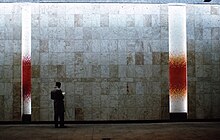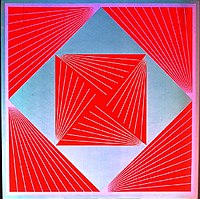Op art

Op art,short foroptical art,is a style of visualartthat usesoptical illusions.[1]
Op artworks are abstract, with many better-known pieces created in black and white. Typically, they give the viewer the impression of movement, hidden images, flashing and vibrating patterns, or swelling or warping.
History
[edit]

Illusionism,focused on the perception of extended space within a flat picture, is found from the earliest points of art history. However, the antecedents of op art, in terms of graphic effects and concern for exotic optical illusions, can be traced back toNeo-Impressionism,Cubism,Futurism,ConstructivismandDada.[2]TheDivisionists,a group of Neo-Impressionist painters, attempted to increase the apparentluminosityof their paintings through recourse to optics and optical illusions.[3]László Moholy-Nagyproduced photographic op art and taught the subject in theBauhaus;one of his lessons consisted of making his students produce holes in cards and then photographing them.[citation needed]
Timemagazine coined the termop artin 1964, in response toJulian Stanczak's showOptical Paintings at theMartha Jackson Gallery,to mean a form of abstract art (specifically non-objective art) that uses optical illusions.[4][5]Works now described as "op art" had been produced for several years beforeTime's1964 article. For instance,Victor Vasarely's paintingZebras(1938) is made up entirely ofcurvilinearblack and white stripes not contained by contour lines. Consequently, the stripes appear to both meld into and burst forth from the surrounding background. Also, the early black and white "dazzle" panels thatJohn McHaleinstalled at theThis Is Tomorrowexhibit in 1956 and hisPandoraseries at theInstitute of Contemporary Artsin 1962 demonstrate proto-op art tendencies.Martin Gardnerfeatured op art and its relation to mathematics in his July 1965Mathematical Games columninScientific American.In Italy,Franco Grignani,who originally trained as an architect, became a leading force of graphic design where op art orkinetic artwas central. His Woolmark logo (launched in Britain in 1964) is probably the most famous of all his designs.[6]



Op art perhaps more closely derives from theconstructivistpractices of theBauhaus.[7]This German school, founded byWalter Gropius,stressed the relationship of form and function within a framework of analysis and rationality. Students learned to focus on the overall design or entire composition to present unified works. Op art also stems fromtrompe-l'œilandanamorphosis.Links with psychological research have also been made, particularly withGestalt theoryandpsychophysiology.[2]When the Bauhaus was forced to close in 1933, many of its instructors fled to the United States. There, the movement took root inChicagoand eventually at theBlack Mountain CollegeinAsheville, North Carolina,whereAnniandJosef Alberseventually taught.[8]
Op artists thus managed to exploit various phenomena, "writes Popper," the after-image and consecutive movement; line interference; the effect of dazzle; ambiguous figures and reversible perspective; successive colour contrasts and chromatic vibration; and in three-dimensional works different viewpoints and the superimposition of elements in space.[2]
In 1955, for the exhibitionMouvementsat theDenise Renégallery in Paris, Victor Vasarely andPontus Hultenpromoted in their "Yellow manifesto" some new kinetic expressions based on optical and luminous phenomenon as well as painting illusionism. The expressionkinetic artin this modern form first appeared at theMuseum für GestaltungofZürichin 1960, and found its major developments in the 1960s. In most European countries, it generally includes the form of optical art that mainly makes use ofoptical illusions,like op art, as well as art based on movement represented byYacov Agam,Carlos Cruz-Diez,Jesús Rafael Soto,Gregorio VardanegaorNicolas Schöffer.From 1961 to 1968, theGroupe de Recherche d'Art Visuel(GRAV) founded byFrançois Morellet,Julio Le Parc,Francisco Sobrino,Horacio Garcia Rossi,Yvaral,Joël Stein andVera Molnárwas a collective group of opto-kinetic artists that—according to its 1963 manifesto—appealed to the direct participation of the public with an influence on its behavior, notably through the use of interactivelabyrinths.
Some members of the groupNouvelle tendance(1961–1965) in Europe also were engaged in op art as Almir Mavignier andGerhard von Graevenitz,mainly with their serigraphics. They studied optical illusions. The termopirritated many of the artists labeled under it, specifically including Albers and Stanczak. They had discussed upon the birth of the term a better label, namelyperceptual art.[9]From 1964, Arnold Schmidt (Arnold Alfred Schmidt) had several solo exhibitions of his large, black and white shaped optical paintings exhibited at theTerrain Galleryin New York.[10]
The Responsive Eye
[edit]In 1965, between February 23 and April 25, an exhibition calledThe Responsive Eye,created by William C. Seitz, was held at theMuseum of Modern Artin New York City and toured to St. Louis, Seattle, Pasadena, and Baltimore.[11][12]The works shown were wide-ranging, encompassing the minimalism ofFrank StellaandEllsworth Kelly,the smooth plasticity ofAlexander Liberman,the collaborative efforts of theAnonima group,alongside the well-knownWojciech Fangor,Victor Vasarely,Julian Stanczak,Richard Anuszkiewicz,Wen-Ying Tsai,Bridget RileyandGetulio Alviani.The exhibition focused on the perceptual aspects of art, which result both from the illusion of movement and the interaction of color relationships.
The exhibition was a success with the public (visitor attendance was over 180,000),[13]but less so with the critics.[14]Critics dismissed op art as portraying nothing more thantrompe-l'œil,or tricks that fool the eye. Regardless, the public's acceptance increased, and op art images were used in a number of commercial contexts. One ofBrian de Palma's early works was a documentary film on the exhibition.[15]
Method of operation
[edit]Black-and-white and the figure-ground relationship
[edit]Op art is a perceptual experience related to how vision functions. It is a dynamic visual art that stems from a discordantfigure-groundrelationship that puts the two planes—foreground and background—in a tense and contradictory juxtaposition. Artists create op art in two primary ways. The first, best known method, is to create effects through pattern and line. Often these paintings areblack and white,or shades of gray (grisaille)—as in Bridget Riley's early paintings such asCurrent(1964), on the cover ofThe Responsive Eyecatalog. Here, black and white wavy lines are close to one another on the canvas surface, creating a volatile figure-ground relationship.Getulio Alvianiused aluminum surfaces, which he treated to create light patterns that change as the watcher moves (vibrating texture surfaces). Another reaction that occurs is that the lines create after-images of certain colors due to how the retina receives and processes light. AsGoethedemonstrates in his treatiseTheory of Colours,at the edge where light and dark meet, color arises because lightness and darkness are the two central properties in the creation of color.[citation needed]
Color
[edit]Beginning in 1965Bridget Rileybegan to produce color-based op art;[16]however, other artists, such asJulian StanczakandRichard Anuszkiewicz,were always interested in making color the primary focus of their work.[17]Josef Alberstaught these two primary practitioners of the "Color Function" school atYalein the 1950s. Often, colorist work is dominated by the same concerns of figure-ground movement, but they have the added element of contrasting colors that produce different effects on the eye. For instance, in Anuszkiewicz's "temple" paintings, the juxtaposition of two highly contrasting colors provokes a sense of depth in illusionistic three-dimensional space so that it appears as if the architectural shape is invading the viewer's space.
-
Victor Vasarely,Kezdi-Ga, 1970, Serigraph, Edition of 250, 20 × 20 in
-
Intrinsic Harmony,by Richard Anuszkiewicz, 1965
Similarities with other art styles
[edit]Although op art is a unique style, it has similarities with styles such asabstract expressionism(color field painting). Although color field painting does not give us illusions, similarities can still be found. We can see that both of these styles are minimalist, only a few colors prevail, and no object or plot is shown. These styles can cause us emotion, since there is no clear plot, the human mind itself imagines and interprets it in its own way. Cold colors are usually associated with sadness, while warm colors are associated with joy. Also, op art and color field painting are characterized by the fact that the image is aesthetic and orderly.
Exhibitions
[edit]- L'Œil moteur: Art optique et cinétique 1960–1975,Musée d'art moderne et contemporain, Strasbourg, France, May 13–September 25, 2005.
- Op Art,Schirn Kunsthalle, Frankfurt, Germany, February 17–May 20, 2007.
- The Optical Edge,The Pratt Institute of Art, New York, March 8–April 14, 2007.
- Optic Nerve: Perceptual Art of the 1960s,Columbus Museum of Art, Columbus, Ohio, February 16–June 17, 2007.
- CLE OP: Cleveland Op Art Pioneers,Cleveland Museum of Art, Cleveland, Ohio, April 9, 2011 – February 26, 2012
- Bridget Rileyhas had several international exhibitions (e.g. Dia Center, New York, 2000; Tate Britain, London, 2003; Museum of Contemporary Art, Sydney, 2004).
See also
[edit]- List of op artists
- Divisionism
- Kinetic art
- Binakael(similar patterns in traditional Filipino textiles)
- Chubb illusion
- Cornsweet illusion
- Impossible object
- Lilac chaser
- M. C. Escher
- Mach bands
- Multistable perception
- Optical illusion
- Pattern glare
- Perception
- Peripheral drift illusion
- Same color illusion
- Trompe-l'œil
- Zero (art)
References
[edit]- ^Artspeak, Robert Atkins,ISBN978-1-55859-127-1
- ^abc"The Collection - MoMA".The Museum of Modern Art.RetrievedNovember 5,2017.
- ^Lee, Alan. "Seurat and Science."Art History10 (June 1987): 203-24.
- ^Jon Borgzinner. "Op Art",Time,October 23, 1964.
- ^"Op-Art: History, Characteristics".Visual-Arts-Cork.RetrievedNovember 5,2017.
- ^"The Hypnotic, Mind-bending Work of Italian Designer Franco Grignani".Eye on Design.2019-06-28.Retrieved2019-12-15.
- ^"Op-Art: History, Characteristics".visual-arts-cork.Retrieved2019-12-15.
- ^"Black Mountain College Movement Overview".The Art Story.Retrieved2019-12-15.
- ^Bertholf. "Julian Stanczak: Decades of Light" Yale Press
- ^"A Brief History of the Terrain Gallery".TerrainGallery.org. Archived fromthe originalon April 3, 2010.RetrievedNovember 5,2017.
- ^Seitz, William C. (1965).The Responsive Eye (exhibition catalog)(PDF).New York: Museum of Modern Art.OCLC644787547.RetrievedJanuary 23,2016.
- ^"The Responsive Eye"(PDF)(Press release). New York: Museum of Modern Art. February 25, 1965.RetrievedJanuary 23,2016.
- ^Gordon Hyatt(writer and producer),Mike Wallace(presenter) (1965).The Responsive Eye(Television production). Columbia Broadcasting System, Inc. Archived fromthe originalon 2013-01-03.(Available on YouTube in three sections.)
- ^"MoMA 1965: The Responsive Eye".CoolHunting. Archived fromthe originalon September 28, 2009.RetrievedNovember 5,2017.
- ^Brian De Palma(director) (1966).The Responsive Eye(Motion picture).
- ^Hopkins, David (September 14, 2000).After Modern Art 1945-2000.OUP Oxford. p. 147.ISBN9780192842343.RetrievedNovember 5,2017– via Google Books.
- ^SeeColor Function Painting: The Art of Josef Albers, Julian Stanczak, and Richard Anuszkiewicz,Wake Forest University, reprinted 2002.
Bibliography
[edit]- Frank Popper,Origins and Development of Kinetic Art,New York Graphic Society/Studio Vista, 1968
- Frank Popper,From Technological to Virtual Art,Leonardo Books, MIT Press, 2007
- Seitz, William C. (1965).The Responsive Eye(PDF).New York: Museum of Modern Art. Exhibition catalog.
{{cite book}}:CS1 maint: postscript (link)




